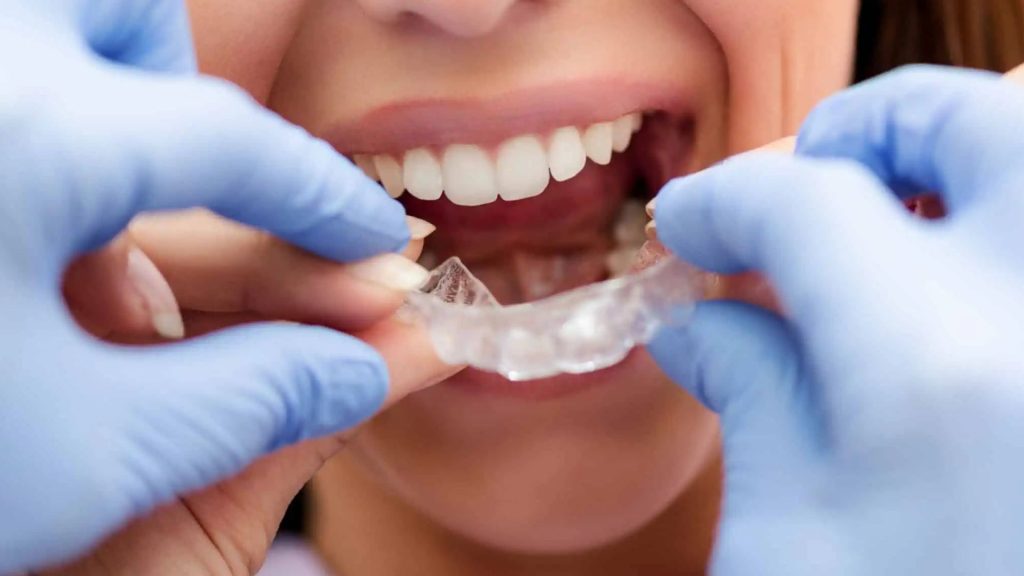Dental Splint
An Occlusal Splint (Night Guard) is a custom-made removable appliance that protects teeth, jaw muscles, and temporomandibular joints (TMJs) from damage caused by bruxism (teeth grinding) or clenching. Acting as a barrier between upper and lower teeth, it prevents grinding. Bruxism affects up to 80% of adults over 25, often due to stress and typically occurring during sleep. Symptoms include tooth wear, jaw pain (Temporomandibular Joint Disorder), and headaches.
Easy-to-wear night splints can effectively address this issue.


Based on your symptoms and a thorough dental check-up, your Spring Orchid Dental dentist may recommend an occlusal splint and discuss its benefits with you.
Signs You May Need an Occlusal Splint
Your dentist is often the first to suggest you might need an occlusal splint.
During a dental check-up, your dentist may notice worn biting surfaces, cracked or chipped teeth, or indentations on your cheeks and tongue. These signs often indicate teeth clenching or grinding.
You might also notice symptoms before visiting your dentist that suggest you need a splint.
- Teeth grinding or clenching sounds noticed by others during sleep.
- Excessive tooth wear, flattened surfaces, chipped or cracked teeth.
- Morning headaches or migraines.
- Jaw pain, stiffness, or soreness in the jaw muscles, face, temples, or ears.
- Pain or difficulty chewing, especially in the morning.
- Tooth sensitivity or unexplained pain.
- Loose teeth without gum disease.
- Fatigue upon waking despite sufficient sleep.
- Notches (abfraction lesions) at the gum line.
- Chronic facial pain or tension.
- Clicking, popping, or grinding sounds from the TMJ.
- Limited ability to open the mouth wide.
What happens if you don’t use a splint as recommended?
Not wearing a splint as instructed can lead to improper healing of the injury due to excessive movement, causing further damage or displacement. It can also result in increased pain and swelling, prolonging recovery time.
The risk of re-injury or worsening of the condition is higher without the splint’s protection and stabilization. Additionally, failing to wear the splint can cause joint stiffness, reduced mobility, and long-term issues.
This non-compliance can delay your return to normal activities and may necessitate further treatment or surgery due to complications or improper healing.
Occlusal Splints in Bassendean, Perth
If you suffer from TMJ disorder or bruxism, oral splints may be an effective treatment for you. Contact your Spring Orchid dentist today. Call us on 08 6155 8999 or request an appointment online.
Monday - Saturday: 8 AM – 5 PM
6/85 Walter Rd E Bassendean WA 6054
FAQs
What are occlusal splints made from?
Occlusal splints are primarily constructed from acrylic material. Many of these splints are clear, which helps to minimize their visibility when worn.
When are occlusal splints worn?
Occlusal splints are typically worn at night during sleep to protect the teeth, jaw muscles, and temporomandibular joints from the effects of bruxism (teeth grinding) or clenching.
How to clean occlusal splints?
- Rinse after every use: Immediately rinse the splint with cold water after removal to eliminate saliva, food particles, or debris.
- Brush gently: Use a soft-bristled toothbrush and mild soap or denture cleaner to gently brush all surfaces, including crevices. Avoid abrasive toothpaste.
- Rinse thoroughly: After brushing, rinse the splint with cold water to remove any soap or cleaner residue.
- Dry completely: Pat dry with a towel or air dry on a flat surface before storing to prevent bacterial growth.
- Weekly deep clean: Soak the splint in denture cleaner or mouthwash and water for 30-60 minutes to remove stains and minerals.
- Store properly: Keep the splint in a clean, dry container away from heat, moisture, and pets when not in use.
- Keep case clean: Regularly wash the storage case with dish soap and water, ensuring it’s completely dry before storing the splint.
Related Search: Sport Mouthguard




